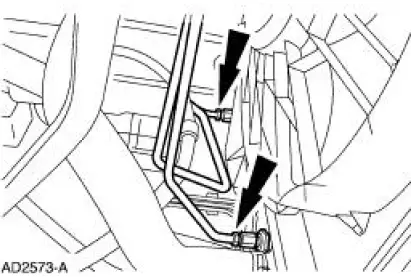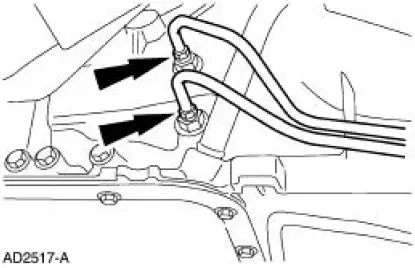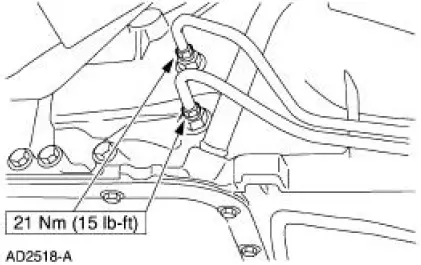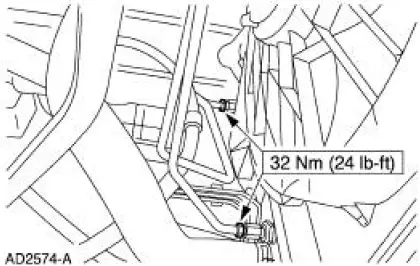Ford Mustang (1999-2004) Service Manual: Transmission Fluid Cooler Tubes
Removal
1. Disconnect the battery cables.
2. Raise and support the vehicle. For additional information, refer to Section.
3. Remove the nuts.

4. Remove the fluid cooler tube bracket at the engine.

5. NOTE: Use a backup wrench to hold the case fitting secure.
Remove the fluid cooler tubes at the transmission.

Installation
1. NOTE: Use a backup wrench to hold the case fitting secure.
Install the fluid cooler tubes at the transmission.

2. Install the fluid cooler tube bracket at the engine.

3. Install the nuts.

4. Lower the vehicle.
5. Connect the battery cables.
6. Fill the transmission with fluid and verify proper operation.
- Use Motorcraft MERCON V Automatic Transmission Fluid XT-5-QM or equivalent meeting MERCON V specification.
 Transmission Cooling
Transmission Cooling
Inspection and Verification
WARNING: Never remove the radiator cap under any conditions while the engine
is
operating. Failure to follow these instructions could result in personal injury
and/or dam ...
 Automatic Transaxle/Transmission External Controls
Automatic Transaxle/Transmission External Controls
Torque Specifications
...
Other materials:
Pinpoint Test I: LFC 33/DTC B1933 - Passenger Air Bag Circuit Resistance
High
Normal Operation
The restraints control module (RCM) monitors the resistance of the
passenger air bag ignitor by
measuring the resistance between pins 6 and 7. If the RCM detects high
resistance between these
pins, it will store a diagnostic trouble cod ...
Noise, Vibration and Harshness (NVH) (Description and Operation)
Noise is any undesirable sound, usually unpleasant in nature. Vibration is
any motion, shaking or
trembling, that can be felt or seen when an object moves back and forth or up
and down. Harshness is
a ride quality issue where the vehicle's response to the ro ...
Lamp Assembly - Fog Lamp (GT)
Removal
1. Raise and support the vehicle.
2. Remove the screw.
3. Partially lower the vehicle and remove the fog lamp assembly.
1. Disconnect the electrical connector.
2. Remove the two screws.
3. Remove the fog lamp assembly and replace the bul ...
